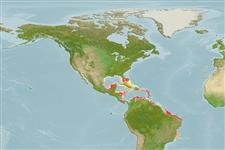Mycale magnirhaphidifera van Soest, 1984
| Native range | All suitable habitat | Point map | Year 2050 |

|
| This map was computer-generated and has not yet been reviewed. |
| Mycale magnirhaphidifera AquaMaps Data sources: GBIF OBIS |
Hochladen Photos
Google Bild |
No photo available for this species.No drawings available for Mycalidae.
Google Bild |
No photo available for this species.
Classification / Names Common names | Synonyms | CoL | ITIS | WoRMS
| Poecilosclerida | Mycalidae
Environment: milieu / climate zone / depth range / distribution range Ökologie
; brackwasser; tiefenbereich 1 - 24 m (Ref. 86836). Tropical; 25°C - 33°C (Ref. 86836)
Verbreitung Länder | FAO Gebiete | Ecosystems | Vorkommen | Einführungen
Western Central Atlantic.
Length at first maturity / Size / Gewicht / Alter
Maturity: Lm ? range ? - ? cm Max length : 0.5 cm OT Männchen/unbestimmt; (Ref. 415)
Kurzbeschreibung Morphologie
Encrusting, up to 0.5 cm thick, very soft and fragile. Raised dermal canals converge to oscula with transparent membranes: 0.1 - 0.3 cm in diameters. Bluish, pinkish or creamy yellowish in shaded zones (Ref. 415).
Maximum thickness: 0.5 cm (Ref. 415). Maximum depth from Ref. 114748. Rare, encrusting mangrove roots (Ref. 415).
Life cycle and mating behavior Geschlechtsreife | Fortpflanzung | Ablaichen | Eier | Fecundity | Larven
Members of the class Demospongiae are hermaphroditic. Life cycle: The zygote develops into parenchymella larva (free-swimming) before settling down on a substrate where it grows into a young sponge.
Hauptreferenz
Referenzen | Koordinator | Partner
Collin, R., M.C. Díaz, J. Norenburg, R.M. Rocha, J.A. Sánchez, M. Schulze, A. Schwartz and A. Valdés. 2005. (Ref. 415)
IUCN Rote Liste Status (Ref. 130435)
CITES Status (Ref. 108899)
Not Evaluated
CMS (Ref. 116361)
Not Evaluated
Bedrohung für Menschen
Harmless
Nutzung durch Menschen
| FishSource |
Tools
Mehr Information
Internet Quellen
BHL | BOLD Systems | CISTI | DiscoverLife | FAO(Publication : search) | Fishipedia | GenBank (Genom, nucleotide) | GloBI | Gomexsi | Google Books | Google Scholar | Google | PubMed | Tree of Life | Wikipedia (Gehe zu, Suchen) | Zoological Record
Estimates based on models
Preferred temperature
(Ref. 115969): 26.3 - 28.4, mean 27.2 (based on 216 cells).
Preiskategorie
(Ref. 80766):
Unknown.


